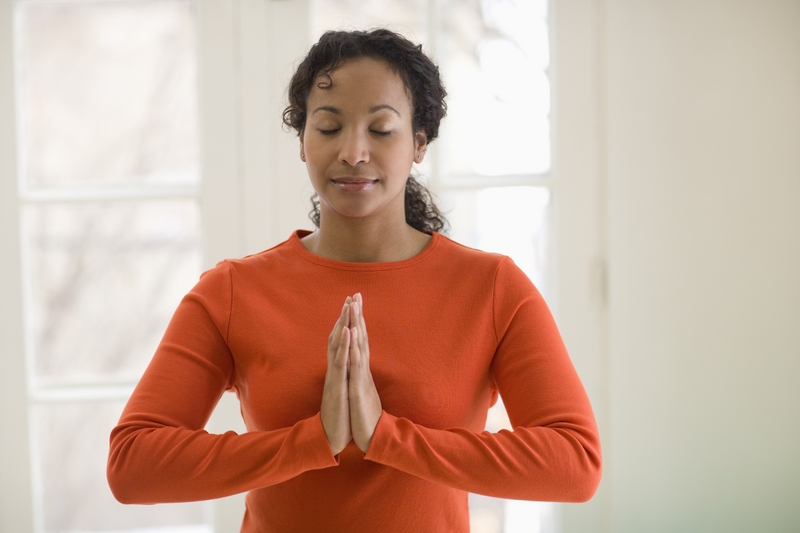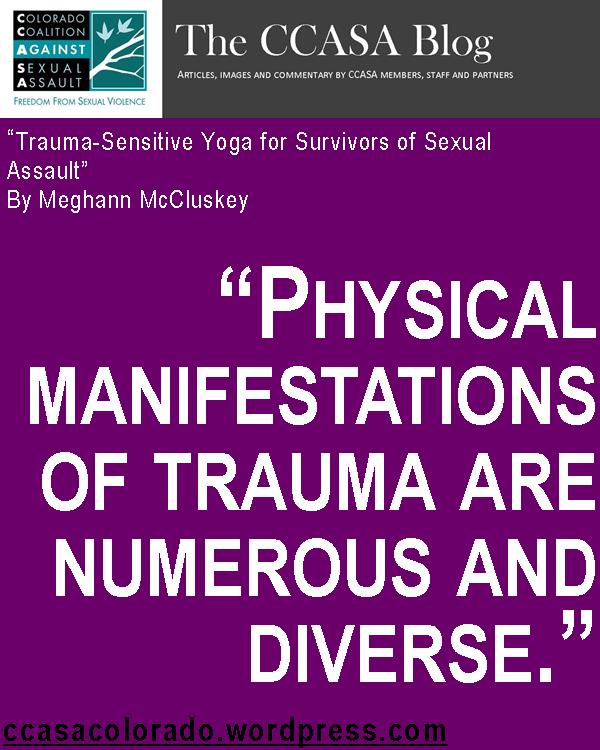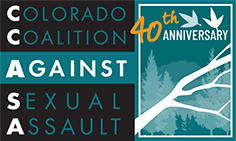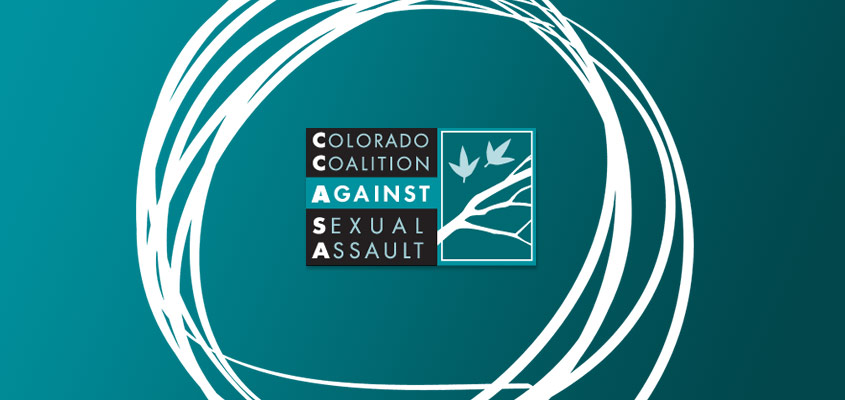By Meghann McCluskey, CCASA Blogger
The past decade in trauma therapy has been marked by a significant incorporation of body-centered and mindfulness techniques into the traditional talk-therapy model. Trauma therapists worldwide are finally taking notice of what many trauma survivors have known throughout time immemorial – trauma does not just impact our thoughts, memories, and behaviors, but it is also often housed in our bodies. Physical manifestations of trauma are numerous and diverse, ranging from mild forms of muscle tension and gastrointestinal discomfort to more serious symptoms such as chronic fatigue and migraine headaches [1]. And while not all trauma survivors  experience physical symptoms per say, many people who endure traumatic events – particularly traumas that are sexually violent in nature – develop distance from, discomfort with, and even fear of their own bodies as a means of coping with the unimaginable violations they have been subjected to.
experience physical symptoms per say, many people who endure traumatic events – particularly traumas that are sexually violent in nature – develop distance from, discomfort with, and even fear of their own bodies as a means of coping with the unimaginable violations they have been subjected to.
At the Rape Assistance and Awareness Program in Denver, we too have been intentionally gravitating towards treatment modalities that support sexual trauma survivors as whole people with minds, bodies, and spirits in need of healing. We were therefore thrilled to launch our first-ever trauma-sensitive yoga group for survivors this past April. As participants of Being in Your Body: A Yoga Therapy and Mindfulness Group, RAAP clients learned over the course of six weeks to maintain awareness in the present moment, to slow their breath in times of distress, and to couple their breathing with gentle yoga postures as a means of achieving relaxation and a sense of groundedness. So how exactly does yoga help survivors heal from the trauma of sexual assault? The following list is by no means comprehensive, but instead reflects just some of the themes emerging from cutting-edge research related to yoga’s therapeutic properties:
- Trauma has a tendency to keep people focused on the past. Trauma survivors often replay traumatic events over and over again in their minds, sometimes even feeling as though they are reliving the traumas they have already survived. Yoga has a strong focus on the present moment and requires participants to focus on the here-and-now as they flow through postures connecting breath to movement. Yoga is sometimes referred to as a “moving meditation,” and it allows sexual trauma survivors to “just be” rather than getting ensnared in unpleasant memories from the past or fears about the future.
- The slow and gentle pace of trauma-sensitive yoga affords survivors the opportunity to become reacquainted with their bodies. Participants are welcomed to make choices from the moment they step onto their yoga mats. They are continually encouraged to decide when they’re ready to back off from a pose or when they wish to challenge themselves to explore further. Unlike some schools of yoga where highly specific alignment principles reign supreme, in trauma-sensitive yoga participants are taught the basics of each posture in order to maintain their safety but are then supported as they attempt to arrive at a position that feels “just right.” This simple act of noticing one’s bodily sensations and making conscious choices related to bodily comfort has the potential to gradually alleviate the sense of alienation many survivors feel towards their physical selves.
- Yoga offers survivors of sexual trauma a sense of mastery that is often robbed from them during their sexually traumatic experiences. By slowly engaging with new postures and ultimately using their bodies intentionally to attain novel physical positions, survivors experience feelings of control and personal power that are essential to the process of healing. It is through this sense of mastery that many survivors also begin to tap into a restored sense of safety and self-worth.
- Therapists trained in the modality of Sensory Experiencing speak of the energy that is often trapped in the body during traumatic experiences – energy that then yearns for release. Yoga affords participants the chance to move energy through their bodies and release emotions that are often stored in large muscle groups such as the hips and shoulders. It is also now widely known that deep breathing like the type practiced in yoga cues the body’s parasympathetic nervous system – the nervous system activated during rest and relaxation – thereby turning off the sympathetic nervous system responsible for our body’s fight, flight, or freeze response. Many trauma survivors are on perpetual high alert and have sympathetic nervous systems in constant overdrive [2]. Yoga represents the rare opportunity for slowing down and experiencing stillness. Moreover, individuals with nervous systems stuck in sympathetic mode often have high levels of cortisol in their bodies. Cortisol is an important chemical that rallies the body to fight, flee, or freeze in moments of crisis, but in excess cortisol can contribute to weight problems, high blood pressure, and other physical ailments. Dropping into parasympathetic mode during yoga allows participants to lower the amount of cortisol in their systems [3].
- Last but certainly not least, practicing trauma-sensitive yoga in a group setting provides trauma survivors with an important weekly occasion for experiencing social interaction and community. Sexual trauma in particular can be a very isolating and shame-inducing occurrence for survivors. Learning yoga in a group setting with others who have endured sexual assault allows survivors to lessen their feelings of alienation and self-blame. The fact that most trauma-sensitive yoga groups do not involve intensive verbal processing can be hugely beneficial for some survivors who are ready to feel more at home in their bodies but hesitant to speak directly about the trauma they have lived through.
For more information about trauma-sensitive yoga, Emerson and Hopper’s book Overcoming Trauma Through Yoga: Reclaiming Your Body is an excellent resource. For more information about RAAP’s trauma-sensitive yoga group, please contact Meghann McCluskey at mmccluskey@raap.org.

Meghann McCluskey, LCSW, RYT, is the Southeast Office Therapist for the Rape Assistance and Awareness Program (RAAP) in Denver.
[1] Levine, P. (2010). In an Unspoken Voice: How the Body Releases Trauma and Restores Goodness. North Atlantic Books: Berkeley, CA.
[2] Levine, P. (2010). In an Unspoken Voice: How the Body Releases Trauma and Restores Goodness. North Atlantic Books: Berkeley, CA.
[3] Bergland, C. (2013). Cortisol: Why the “Stress Hormone” is Public Enemy No. 1. Psychology Today. psychologytoday.com


3 thoughts on “Being in Your Body: The Benefits of Trauma-Sensitive Yoga for Survivors of Sexual Assault”